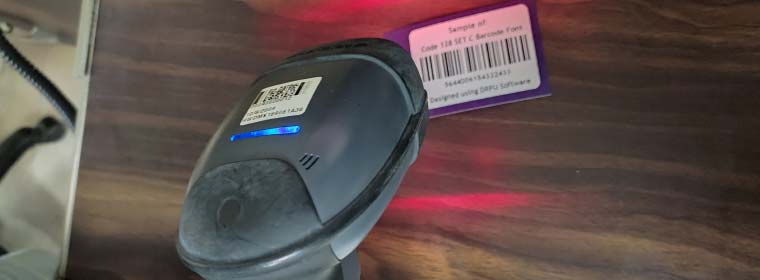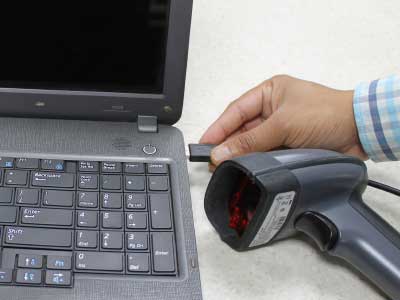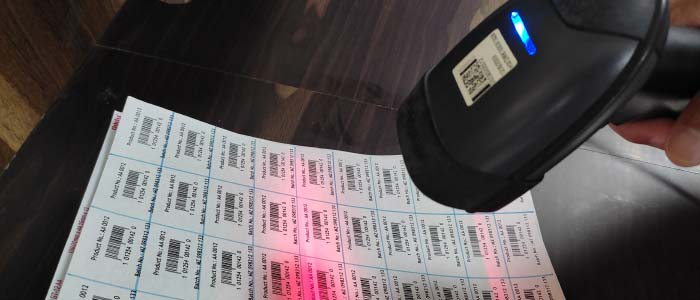There are several types of barcode scanners available on the market, each with its own unique features and capabilities. Here are some of the most common types of barcode scanners:
-
01
Handheld Barcode Scanner:
These are the most common type of barcode scanner, and they are held by the user to scan barcodes. Handheld scanners are available in both corded and cordless varieties, and can read both linear and 2D barcodes.
-
02
Fixed-Mount Barcode Scanner:
Fixed-mount scanners are stationary and are typically used in manufacturing and logistics applications where products move along a conveyor belt. They can read both linear and 2D barcodes.
-
03
Presentation Barcode Scanner:
Presentation scanners are often used in retail applications where products are presented to the scanner, such as at a checkout counter or service desk. They can read both linear and 2D barcodes.
-
04
Wearable Barcode Scanner:
Wearable scanners are worn on the user's body, such as on a wristband or glove. They are often used in manufacturing and logistics applications where the user needs to keep their hands free.
-
05
Pen-Type Barcode Scanner:
Pen-type scanners are lightweight and compact, and are held like a pen to scan barcodes. They are often used for point-of-sale (POS) applications.
-
06
2D Imager Barcode Scanner:
These scanners use a camera-like system to capture and read 2D barcodes. They can also read linear barcodes and are commonly used in retail and logistics.
-
07
PDA/Smartphone Barcode Scanner:
These scanners are built into Smartphone and PDAs, and use the device's camera to scan barcodes. They are commonly used for mobile inventory management and asset tracking.
Each type of barcode scanner has its own advantages and disadvantages, and the selection of the appropriate scanner will depend on the specific needs of the user and use the application. Factors to consider include the type of barcode being read, the scanning distance, the speed of scanning, and the environment in which the scanner will be used.
Specifications of a Barcode Scanner:
The scanning speed and accuracy specifications of a barcode scanner can vary depending on the specific model and manufacturer. However, some general guidelines for these specifications are:
Accuracy: Barcode scanners are designed to read barcodes accurately and with minimal errors. The accuracy of a barcode scanner is typically measured in terms of its "read rate," which is the percentage of barcodes that are read correctly. High-quality scanners can have a read rate of 99% or higher.

-
01 Durability:Barcode scanners may be exposed to harsh environments and rough handling, so they need to be designed to withstand such conditions. High-quality scanners are typically built to withstand drops, spills, and other types of wear and tear.
-
02 Scanning Distance:The Scanning Distance of a barcode scanner depends on the type of barcode being scanned and the type of scanner being used. Handheld scanners can typically read barcodes from a distance of a few inches to several feet away.
-
03 Scanning Angle:The Scanning Angle refers to the range of angles at which a barcode scanner can read a barcode. Most handheld scanners have an omnidirectional scanning pattern that allows them to read barcodes at any angle.
Scanning speed: Barcode scanners typically have a scan rate that ranges from 100 to 1,000 scans per second. The scan rate refers to the speed at which the scanner can read and decode a barcode.
→ Overall, the scanning speed and accuracy specifications of a barcode scanner should be chosen based on the specific requirements of the application. Factors to consider include the volume of scanning required, the distance and angle at which barcodes need to be read, and the durability needed for the scanner to withstand the environment in which it will be used.
Download and Install
Business Barcode Label Maker SoftwareReading Range and Depth of Field Specification:
The Reading Range of a barcode scanner refers to the maximum distance from which it can read a barcode. This distance can vary widely, from a few millimetres for handheld scanners to several feet for fixed-position scanners.
The Depth of Field of a barcode scanner refers to the range of distances over which it can read a barcode with acceptable accuracy. This range can vary depending on the type of scanner and the specific model.
For Example, a handheld laser scanner may have a reading range of a few inches to a few feet, and a depth of field of a few inches to several inches. A fixed-position scanner, on the other hand, may have a reading range of several feet or more, and a depth of field of several inches to several feet.
Important Factor:
⇒ It's important to note that other factors can also affect the reading range and depth of field of a barcode scanner, including the type of barcode being scanned, the size and quality of the barcode, and the lighting conditions in the scanning environment. It's always a good idea to consult the specifications of a specific barcode scanner model to determine its reading range and depth of field, and to test the scanner in the actual scanning environment to ensure optimal performance.
Connectivity Options:
Barcode scanners can have various connectivity options depending on the model and manufacturer and choice of connectivity will depend on the specific use case, desired level of flexibility and mobility required. The most common connectivity options for barcode scanners include:

- Cloud: Cloud-based barcode scanners use the internet to connect to a cloud-based software system. This type of connectivity allows for real-time tracking and data management of scanned items.
- Wired: Barcode scanners can be connected to a device, such as a computer or POS terminal, using a wired connection. The most common wired connection options are USB, serial, and keyboard wedge.
- Mobile: Mobile barcode scanners are integrated with smartphones or tablets and use the device's built-in camera to scan barcodes. This type of connectivity is convenient for mobile workers who need to scan barcodes while on-the-go.
- Wireless: Wireless barcode scanners can connect to a device through Bluetooth, Wi-Fi, or RF (radio frequency) technology. This type of connectivity allows for greater flexibility and mobility in scanning items without being tethered to a device.
Benefits of a Barcode Scanner:
There are many benefits to using a barcode scanner and these can help in businesses streamline operations, reduce costs, and improve customer services.
Cost Savings:
Barcode scanners can help businesses reduce labor costs by automating tasks that would otherwise require manual data entry or tracking.
Enhanced Customer Service:
Barcode scanners can help businesses improve customer service by providing accurate and up-to-date information about product availability and shipping times.
Data Collection and Analysis:
Barcode scanners can collect data about products and customers, which can be used to inform business decisions and improve marketing strategies.
Increased Speed and Accuracy:
Barcode scanners can read and process information much faster and more accurately than humans. This can improve productivity and reduce errors.
Improved Inventory Management:
Barcode scanners can help businesses keep track of inventory levels, monitor stock levels, and identify when items need to be restocked.
Integration with other systems:
Barcode scanners can be integrated with other business systems, such as point-of-sale systems, inventory management software, and shipping software, to improve overall efficiency and accuracy.
Some Issues of using a Barcode Scanner:
-
01
Battery Problems
Wireless barcode scanners rely on batteries to function, and if the battery is low or not charged, the scanner may not work properly.
-
02
Compatibility Issues
Barcode scanners may not be compatible with certain software or operating systems, leading to issues when trying to use the scanner.
-
03
Barcode Data Errors
If the barcode scanner is not configured properly or if the barcode label is damaged or poorly printed, it can result in errors in the data that is captured.
-
04
Enviornmentals Factors
Factors such as lighting, temperature, and humidity can affect the performance of barcode scanners, particularly those that rely on optical scanning technology.
-
05
Poor Scanning Performance
If a barcode scanner is not able to scan barcodes properly, it may be due to a variety of issues such as poor quality barcodes, incorrect scanning technique, or a malfunctioning scanner.
-
06
Connectivity Problems
Barcode scanners may experience connectivity issues if they are not properly configured, if the device they are connected to is not functioning properly, or if there is a problem with the cable or wireless connection.
-
07
Malfunctioning Hardware
Over time, barcode scanners may experience hardware issues such as a broken scan button or a faulty trigger, which can affect the scanner's ability to function properly.
